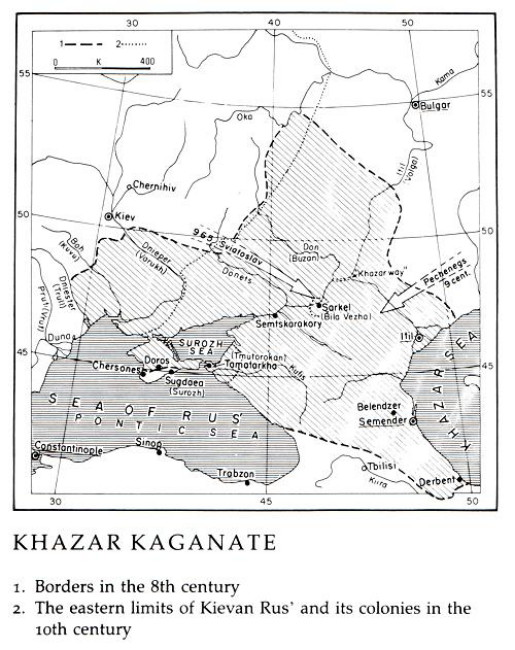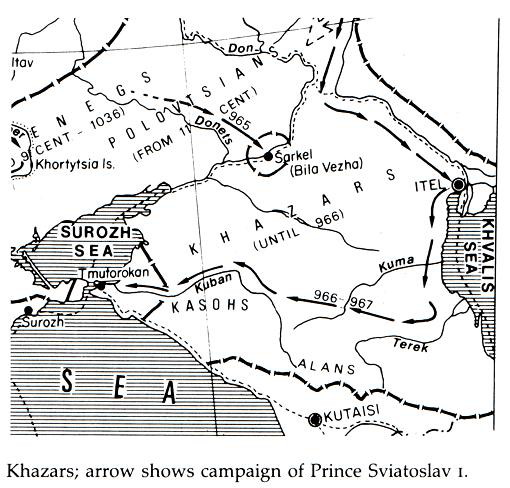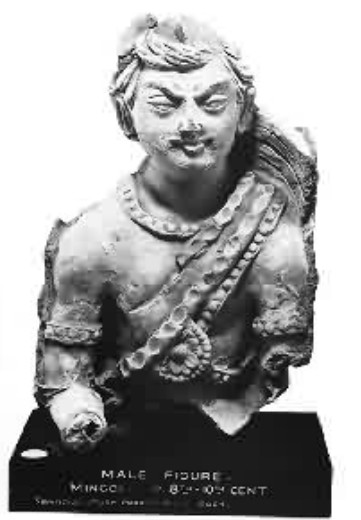Khazars
Khazars (Ukrainian: хозари; khozary). Seminomadic, Turkic-speaking people that appeared in southeastern Europe after the expulsion of the Huns in the 4th century and lived in the area until the 11th century. They were the eastern neighbors of the eastern Slavic tribes and then of Kyivan Rus’. There are various hypotheses on the origin of the Khazars; they considered themselves close to the Volga Bulgars, Oghuz, and Avars. The territory first settled by them encompassed the Caspian steppes between the Sulak River and the lower Don River. At first the Khazars were nomads and herders, but eventually some of them turned to farming and especially trade.
From the second half of the 6th century the Khazars were ruled by the western Turkic kaganate. After the dissolution of the kaganate in the middle of the 7th century, the Khazars conquered some of the Bulgar and other Caucasian (eg, Alans) and Slavic tribes, and established the Khazar kaganate, the first state in eastern Europe. The supreme sovereign was the kagan, the high priest, but the actual ruler was the vicegerent or assistant kagan. The kaganate's first capital was Semender (Samandar) in northern Daghestan. In the mid-8th century, under pressure from the Arabs to the south, the capital was transferred to Itil on the Volga River, near present-day Astrakhan. Itil became an important trade center between East and West. In 835 the fortified city of Sarkil was built on the Don River with the help of Byzantine craftsmen. Among its inhabitants were many Rus’, Greek, Iranian, and central-Asian merchants.
The Khazar kaganate reached its zenith in the late 8th century when it gained control over Subcaucasia, the Sea of Azov steppe, and most of eastern Europe up to the Dnipro River. The proto-Ukrainian Siverianians and Polianians paid tribute to the Khazars. The kaganate dominated the trade routes between the Far East and Byzantium and between the Arabic Empire and the Slavic territories and Scandinavia to the north. Until the mid-10th century, Khazar trade with these centers was interrupted only by intermittent wars between these same powers.
At the beginning of the 8th century, Jews from Iran and Byzantium settled among the Khazars in northern Daghestan. Although some Khazars soon converted to Judaism, it was only at the beginning of the 9th century that Kagan Obadiah proclaimed non-Talmudic Judaism the state religion. Prior to that (ca 735), Arabs had invaded the kaganate and forced some members of the ruling class to adopt Islam. Meanwhile, Byzantium tried to convert the Khazars to Christianity: in 860–1 Saint Cyril conducted a mission among them and a metropoly with seven eparchies was organized. The Khazars even played a role in spreading Christianity in Kyivan Rus’ before its official conversion under Volodymyr the Great. All of these faiths coexisted peacefully on Khazar territory.
In the late 9th century the Black Sea steppes (southern Ukraine) that were under Khazar control were invaded by the Pechenegs, whose incessant raids on the kaganate considerably weakened the Khazarstate. From the late 9th century Kyivan Rus’ also emerged as a major opponent. According to the chronicles, Askold and Dyr's Varangian troops liberated Kyiv from the Khazars in 862, and in 883–5 Prince Oleh freed the Polianians and Siverianians from Khazar rule. Prince Ihor's army twice (913–14 and 943–4) marched through Khazarian territory to the Caspian Sea and brought back rich booty. In his 941 campaign against Byzantium, however, Ihor received support from the kaganate and there were Christian Khazars among his warriors.
In 964–5 Prince Sviatoslav I Ihorovych inflicted the final blow to the Khazar state: he destroyed Itil and Semender, and annexed Sarkil and the northwestern part of Khazar territory to Kyivan Rus’ (see Tmutorokan principality). This action proved to be detrimental to Rus’, which became vulnerable to constant nomadic invasions from the east. In 985 Volodymyr the Great defeated the Volga Bulgars and Khazars and forced them to pay tribute. The Khazars are last mentioned in the chronicles under the year 1079 when they conspired to seize Prince Oleh (Mykhailo) Sviatoslavych in Tmutorokan and hand him over to the Byzantine emperor. After the fall of the kaganate, the Khazars gradually intermixed with the Turkic and Cuman populations and eventually disappeared as a distinct people.
BIBLIOGRAPHY
Rybakov, B. ‘K voprosu o roli Khazarskogo kaganatu v istorii Rusi,’ Sovetskaia arkheologiia, 18 (1953)
Dunlop, D. The History of the Jewish Khazars (New York 1954)
Artamonov, M. Istoriia khazar (Leningrad 1962)
Pletneva, S. Khazary (Moscow 1976)
Pritsak, O. ‘The Khazar Kingdom's Conversion to Judaism,’ HUS, 2 (1978), no. 3
Arkadii Zhukovsky
[This article originally appeared in the Encyclopedia of Ukraine, vol. 2 (1988).]


